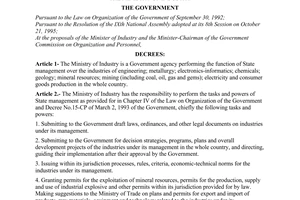Nội dung toàn văn Circular No. 03-TT/KHDT of March 26, 1997, guiding the import of chemicals according to Decision No.28-TTg of January 13, 1997 of the Prime Minister
|
THE MINISTRY OF
INDUSTRY |
SOCIALIST
REPUBLIC OF VIET NAM |
|
No. 03-TT/KHDT |
Hanoi, March 26, 1997 |
CIRCULAR
GUIDING THE IMPORT OF CHEMICALS ACCORDING TO DECISION No.28-TTg OF JANUARY 13, 1997 OF THE PRIME MINISTER
Pursuant to Decision
No.28-TTg of January 13, 1997 of the Prime Minister on the 1997 commodities and
import-exports management policy;
Considering the real demand for the use of chemicals and the capacity of
domestic production in 1996;
Pursuant to Decree No.74-CP of November 1, 1995 of the Government defining the
function, task, power and organization of the Ministry of Industry;
The Ministry of Industry gives the following guidance on the import of
chemicals in 1997:
I. GENERAL PROVISIONS:
1. All enterprises of different forms (production, trading), regardless of what economic sector they belong to, are permitted to import chemicals if they meet the following conditions:
-Having a Decision on enterprise establishment as stipulated by the Government; Registering their occupation as chemical producer or trader or having a real demand for use of chemicals in production.
-Having a License for the import and export of chemicals.
The chemical branch here is taken to mean "Means of production, materials and raw materials for production" written in the import-export license issued by the Ministry of Trade to Enterprises.
2. Those Enterprises which have all the conditions mentioned in Point 1 are permitted to import chemicals (except toxic chemicals) according to their demand and economic contract.
II. SPECIFIC PROVISIONS:
1.With regard to those chemicals which the country can produce to basically meet demand in quantity and quality, only a supplementary quantity of them is allowed to be imported on the principle that the chemicals so imported must have an equal (or higher) quality, and an equal (or cheaper) price than those chemicals of the same kind domestically produced.
2.The import of toxic chemicals is banned as stipulated in Decision No.28-TTg of January 13, 1997 of the Prime Minister. The import of raw chemical materials for the production of toxic chemicals must be considered and permitted by the Ministry of Trade on a case-by-case basis.
3.Only a supplementary quantity of those chemicals which the country can produce to basically meet demand and the estimated demand should be imported in 1997, and a list of these chemicals is provided in Supplement 1. This list shall be re-considered and adjusted every year according to demand and to the ability of domestic production to try to meet it. The Ministry of Trade and the General Department of Customs are requested to base themselves on this List to supervise and regulate imports by the enterprises.
4.The import of chemicals as raw materials for the production of plant protection substances and of plant protection chemicals must comply with the Ordinance on Plant Protection and Epidemic Control issued on February 15,1993 and the guidance of the Ministry of Agriculture and Rural Development.
5.The import of addictive substances, nerve-affecting substances and base substances used in medical treatment and pharmaceutical production must be licensed by the Ministry of Health as stipulated by Decree No.89-CP of December 15, 1995.
6.The importers of chemicals must supply in writing the necessary information (in addition to the documents mentioned in Point 1, Section I) to the Customs Office so that the latter may consider it before permitting the import such as the source of import, the aim of using such chemicals, the quality of goods, and the import price.
7.The imported chemicals must be packed according to their chemical and physical characteristics to ensure safety for their transport and use under the current stipulations of the Government.
III. IMPLEMENTATION PROVISIONS:
This Circular takes effect from the date of its signing to March 31, 1998.
With regard to those orders which had been contracted and for which an L/C had been opened before March 25, 1997 and with regard to those units which had been confirmed in writing by the Ministry of Industry before the issue of this Circular, they should be allowed by the Ministry of Trade and the General Department of Customs to continue carrying it out. When the demand for import surpasses the estimated level, the General Department of Customs is requested to consider and permit supplementary imports, and at the same time, inform the Ministry of Industry for adjusting.
The Ministry of Industry requests the other Ministries, the ministerial-level agencies, the agencies attached to the Government, the People’s Committees of the provinces and cities directly under the Central Government, and the central agencies of mass organizations to popularize the contents of this Circular to the enterprises under their management for implementation, and at the same time, inform the Ministry of Industry about any problems that may arise during its implementation, so that the latter may adjust them.
|
|
FOR
THE MINISTER OF INDUSTRY, |
SUPPLEMENT
LIST
OF CHEMICALS WHICH THE COUNTRY CAN PRODUCE TO BASICALLY MEET DEMAND, AND OF
WHICH ONLY A SUPPLEMENTARY QUANTITY IS ALLOWED TO BE IMPORTED IN 1997
(issued together with Circular No.3-TT/KHDT of March 26, 1997 of the Minister
of Industry)
DOMESTIC 1997
NAMES OF CHEMICALS QUALITY PRODUCTION DEMAND
(TON) (TON)
1. Chlohydric acid TCVN 1556-96
HCl content>30% 15,000 15,000
Fe contents<0.01%
2. Sulphuric acid H2SO4 contents 97% 30,000 30,000
(technical)
3. Sulphuric acid TCVN 138-64 2,000 2,000
(battery) H2SO4 contents>92%
Fe contents<0.012%
4. Liquid ammonia NH3 contents>99.9% 2,500 2,500
5. Aluminum sulfate Al203 contents>17% 9,000 9,000
6. Aluminum kalinite sulfate Al203 contents>10.5% 16,000 20,000
7. Calcium carbonate CaCO3 contents>98% 16,000 20,000
8. Natrium silicate TCN 38-86 15,000 15,000
Na20 contents>12%
Si02 contents>30%
Modul M=2.5-3
9. Natrium hydroxide 100% TCVN 3793-83 70,000 80,000
NaOH contents>30%
10. Liquid chlorine Cl2 contents>99.5% 1,200 1,200
11. Oxide TCVN 1068-71 8.5 mln m3 8.5 mln m3
02 contents>99.3%
12. Natrium fluosilicate TCVN 1446-73 1,500 1,500
Na2SiF6 contents>98%
13. Calcium chloride CaCl2 contents>90% 2,500 5,000


